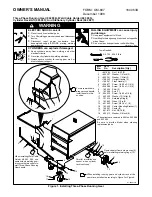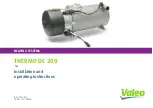
If desired, the K930-2 TIG Module can be used with
the DUAL VANTAGE
®
700. The settings are for refer-
ence.
DUAL VANTAGE
®
700 settings when using the K930-
2 TIG Module with an Amptrol or Arc Start Switch:
• Set the MODE Switch to the TOUCH START TIG
setting.
• Set the "IDLER" Switch to the "AUTO" position.
• Set the "WELDING TERMINALS" switch to the
"REMOTELY CONTROLLED" position.
This will keep the "Solid State" contactor open and
provide a "cold" electrode until the Amptrol or Arc
Start Switch is pressed.
When using the TIG Module, the OUTPUT CONTROL
on the DUAL VANTAGE
®
700 is used to set the maxi-
mum range of the CURRENT CONTROL on the TIG
Module or an Amptrol if connected to the TIG Module.
NOTE:
The TIG process is to receive a low voltage
welding process. There is no difference in
operation with the VRD “On” or “Off” for this
mode. For indicator light operation, see
Table
B.1.
TIG WELDING
The TOUCH START TIG setting of the MODE switch
is for DC TIG (Tungsten Inert Gas) welding. To initiate
a weld, the OUTPUT CONTROL dial is first set to the
desired current and the tungsten is touched to the
work. During the time the tungsten is touching the
work there is very little voltage or current and, in gen-
eral, no tungsten contamination. Then, the tungsten is
gently lifted off the work in a rocking motion, which
establishes the arc.
When in the TOUCH START TIG mode and when a
Amptrol is connected to the 6-Pin connector the OUT-
PUT CONTROL dial is used to set the maximum cur-
rent range of the current control of the Amptrol.
The ARC CONTROL is not active in the TIG mode. To
STOP a weld, simply pull the TIG torch away from the
work.
When the arc voltage reaches approximately 30 Volts
the arc will go out and the machine will reset the cur-
rent to the Touch Start level.
To reinitiate the arc, retouch the tungsten to the work
and lift. Alternatively, the weld can be stopped by
releasing the Amptrol or arc start switch.
The DUAL VANTAGE
®
700 an be used in a wide vari-
ety of DC TIG welding applications. In general the
‘Touch Start’ feature allows contamination free start-
ing without the use of a Hi-frequency unit.
B-8
OPERATION
DUAL VANTAGE
®
700
TYPICAL CURRENT RANGES
(1)
FOR TUNGSTEN ELECTRODES
(2)
Tungsten Electrode DCEN (-) DCEP (+) Approximate Argon Gas Flow
TIG TORCH
Diameter in. (mm)
Flow Rate C.F.H. ( l /min.)
Nozzle Size (4), (5)
1%, 2% Thoriated 1%, 2% Thoriated Aluminum
Stainless Steel
Tungsten
Tungsten
.010 (.25) 2-15
(3)
3-8
(2-4)
3-8
(2-4)
#4, #5, #6
0.020
(.50) 5-20
(3)
5-10
(3-5)
5-10
(3-5)
0.040
(1.0) 15-80
(3)
5-10
(3-5)
5-10
(3-5)
1/16
(1.6) 70-150
10-20
5-10
(3-5)
9-13
(4-6)
#5, #6
3/32
(2.4) 150-250
15-30
13-17 (6-8)
11-15
(5-7)
#6, #7, #8
1/8
(3.2)
250-400
25-40
15-23 (7-11)
11-15
(5-7)
5/32
(4.0) 400-500
40-55
21-25
(10-12)
13-17
(6-8)
#8, #10
3/16
(4.8) 500-750
55-80
23-27 (11-13)
18-22
(8-10)
1/4
(6.4)
750-1000
80-125
28-32
(13-15)
23-27
(11-13)
(1) When used with argon gas. The current ranges shown must be reduced when using argon/helium or pure helium shielding gases.
(2) Tungsten electrodes are classified as follows by the American Welding Society (AWS):
Pure
EWP
1% Thoriated
EWTh-1
2% Thoriated
EWTh-2
Though not yet recognized by the AWS, Ceriated Tungsten is now widely accepted as a substitute for 2% Thoriated Tungsten in AC and DC applications.
(3) DCEP is not commonly used in these sizes.
(4) TIG torch nozzle "sizes" are in multiples of 1/16ths of an inch:
# 4 = 1/4 in.
(6 mm)
# 5 = 5/16 in.
(8 mm)
# 6 = 3/8 in.
(10 mm)
# 7 = 7/16 in.
(11 mm)
# 8 = 1/2 in.
(12.5 mm)
#10 = 5/8 in.
(16 mm)
(5) TIG torch nozzles are typically made from alumina ceramic. Special applications may require lava nozzles, which are less prone to breakage, but cannot withstand high temperatures
and high duty cycles.
TABLE B.3
Summary of Contents for DUAL VANTAGE 700
Page 30: ...B 11 NOTES DUAL VANTAGE 700 ...
Page 32: ...C 2 NOTES DUAL VANTAGE 700 ...
Page 38: ...D 6 NOTES DUAL VANTAGE 700 ...
Page 43: ...E 5 NOTES DUAL VANTAGE 700 ...
Page 46: ...F 3 CONNECTION DIAGRAMS DUAL VANTAGE 700 ...
Page 48: ...F 5 CONNECTION DIAGRAMS DUAL VANTAGE 700 ...
Page 49: ...F 6 CONNECTION DIAGRAMS DUAL VANTAGE 700 ...
Page 51: ...F 8 CONNECTION DIAGRAMS DUAL VANTAGE 700 ...
Page 52: ...F 9 CONNECTION DIAGRAMS DUAL VANTAGE 700 ...
Page 53: ...F 10 CONNECTION DIAGRAMS DUAL VANTAGE 700 ...
Page 54: ...F 11 CONNECTION DIAGRAMS DUAL VANTAGE 700 ...
Page 55: ...F 12 CONNECTION DIAGRAMS DUAL VANTAGE 700 2 9 03 ...
Page 56: ...F 13 CONNECTION DIAGRAMS DUAL VANTAGE 700 ...
















































